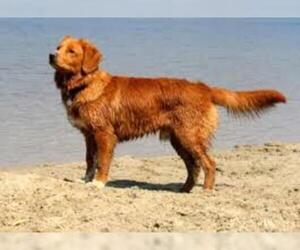
All about Nova Scotia Duck Tolling Retriever dog breed
A.K.A. :Toller, Little River Duck Dog, Yarmouth Toller, Nova Scotia Toller, Canadian Toller
Size
Grooming requirements
Exercise requirements
Good with other dogs
Watchdog ability
Energetic
Training requirements
Playful
Affectionate
Good with other pets
Good with children
Good with strangers
Winter
Summer
Healthiness
Protective
Life Span
| Pure Breeds | Member |
| Breeds A - Z | N |
| Breeds by Group | Gun Dog Sporting |
| Breeds by Trait | Good With Kids High Stamina Dog Breeds Smartest Dog Breeds |
| Overview: | The Nova Scotia Duck Tolling Retriever, often affectionately called a "Toller," is a captivating and intelligent breed originating from Nova Scotia, Canada, where they were developed to "toll" or lure ducks within gunshot range before retrieving them. Physically, Tollers are medium-sized dogs, known for their striking red coats, often with white markings on the chest, feet, and tail tip. They possess a characteristic "tolling" bark, a high-pitched sound used to attract waterfowl, and have an expressive, alert demeanor. Temperamentally, they are affectionate, playful, and highly energetic, thriving on activity and mental stimulation. While their compact size might suggest suitability for apartment living, their high exercise requirements and need for a job to do make them better suited for active families with access to a yard or regular outdoor adventures. They are generally good with children and other pets when properly socialized. As with many purebreds, some health considerations include hip and elbow dysplasia, progressive retinal atrophy (PRA), and autoimmune thyroiditis. |
F.A.Q.
All You Need to Know About the Nova Scotia Duck Tolling Retriever Breed
The Nova Scotia Duck Tolling Retriever, often affectionately called a "Toller," is a medium-sized gundog originating from Yarmouth County, Nova Scotia, Canada. Bred to lure and retrieve waterfowl, Tollers possess an intelligent, high-energy, and affectionate temperament. Physically, they are characterized by their striking foxy-red coat, often with white markings, and a distinctive plumed tail. They are generally good with families and children, but their boundless energy means they require significant daily exercise and mental stimulation; apartment living is not ideal without a dedicated and active owner. Their short, dense, water-repellent coat requires moderate grooming, primarily regular brushing to manage shedding. Common health considerations include hip dysplasia, progressive retinal atrophy, and autoimmune thyroiditis. Potential owners should be prepared for a dedicated, active, and intelligent companion who thrives on engagement and training.Nova Scotia Duck Tolling Retriever WeightThe average weight for a healthy adult Nova Scotia Duck Tolling Retriever ranges from 35 to 50 pounds. * Males: Typically weigh between 40-50 pounds.* Females: Usually weigh between 35-45 pounds. This average size makes them a medium-sized breed. Maintaining a healthy weight for Nova Scotia Duck Tolling Retriever is crucial for their overall well-being.
Here's a clear and informative answer for your breed details FAQ:What is the average height of a Nova Scotia Duck Tolling Retriever in inches?
The Nova Scotia Duck Tolling Retriever height typically falls within a specific range, measured at the shoulder. Understanding their average size is helpful when considering this energetic breed.For adult Tollers, the general height range is:- Males: 18-21 inches
- Females: 17-20 inches
The Nova Scotia Duck Tolling Retriever is officially recognized by major kennel clubs like the AKC in shades of red, ranging from a golden red to a rich copper, often with lighter feathering on the undersides and tail. These AKC recognized Nova Scotia Duck Tolling Retriever colors are the breed standard. White markings are also acceptable on the chest, feet, and tip of the tail. There are no other officially accepted Nova Scotia Duck Tolling Retriever colors.Rare coat types or exotic Nova Scotia Duck Tolling Retriever variations such as blue, lilac, merle, chocolate, brindle, fawn, cream, or solid white are not found in the purebred Nova Scotia Duck Tolling Retriever and are not recognized by the AKC or other major kennel clubs. If you encounter a dog advertised with these Nova Scotia Duck Tolling Retriever colors, it is likely not a purebred Toller or is the result of a crossbreed. Breeders focusing on these non-standard colors may not be adhering to breed health and temperament standards. Potential adopters or buyers should be aware that these uncharacteristic colors are not part of the breed's genetic makeup and are not accepted.
The Nova Scotia Duck Tolling Retriever personality is a delightful blend of intelligence, eagerness, and affection. Tollers are known for their loyal and friendly nature, often described as having a "big dog in a small package" temperament. They are highly sociable and thrive on being part of the family, forming strong bonds with their human companions.Tollers generally exhibit a good disposition with children, especially when raised together and supervised, making them excellent family pets. They are also typically well-behaved with other pets, particularly if socialized from a young age.Regarding adaptability to apartment living, while Tollers are medium-sized, their high energy levels and need for mental stimulation make them better suited for homes with yards or owners committed to providing ample daily exercise. They are not ideal for sedentary lifestyles and can become mischievous if bored or under-exercised. Their temperament of Nova Scotia Duck Tolling Retriever is active, requiring consistent engagement and training to channel their boundless energy positively.
Nova Scotia Duck Tolling Retriever Temperament & PersonalityThe Nova Scotia Duck Tolling Retriever temperament is generally described as affectionate, intelligent, and highly energetic. Tollers are known for their lively and outgoing personality traits, making them engaging companion dogs. They are typically very friendly and sociable with their families and those they know, often displaying a strong desire to be involved in household activities. Their loyalty to their owners is profound, and they thrive on companionship.While generally friendly, they can be somewhat reserved or cautious with strangers initially, but usually warm up quickly once they've assessed the situation. Their high intelligence means they are quick learners, but they can also exhibit a degree of stubbornness at times, requiring consistent and positive reinforcement training. They are also known to be quite sensitive to their owner's tone and mood, so harsh corrections should be avoided.Regarding living arrangements, due to their high energy levels and need for mental and physical stimulation, adaptability to apartment living is generally not ideal unless their exercise and enrichment needs are rigorously met daily. They thrive in homes with yards and active owners who can provide ample opportunities for play, long walks, or dog sports.With children, Tollers are typically good-natured and patient, especially when raised with them. However, as with any breed, supervision is always recommended, particularly with very young children, due to the dog's energy and potential for accidental knocking over. They usually get along well with other pets if properly socialized from a young age, often enjoying the company of other dogs. Early exposure to various people, places, and animals is crucial for developing a well-adjusted Toller.
Nova Scotia Duck Tolling Retriever Care: Daily Maintenance & Health TipsNova Scotia Duck Tolling Retriever care involves moderate grooming, ample exercise, and mindful health management. These intelligent, active dogs require regular attention to thrive.Grooming Needs: Tollers have a medium-length, water-repellent double coat that needs weekly brushing to prevent mats and reduce shedding. During shedding seasons (twice yearly), daily brushing is recommended. Bathe as needed, typically every 1-2 months, using a dog-specific shampoo. Dental care is crucial; brush teeth several times a week to prevent plaque buildup and gum disease. Trim nails every 3-4 weeks. Unlike brachycephalic breeds, Tollers do not have facial wrinkles requiring special cleaning. Their ears should be checked weekly for dirt, redness, or odor, and cleaned gently with a veterinarian-approved solution if needed to prevent ear infections.Exercise Requirements: Despite their "low-energy" appearance, Tollers are highly energetic and intelligent working dogs. They require at least 60-90 minutes of vigorous exercise daily, including walks, runs, fetching, swimming, and engaging mental stimulation like puzzle toys or training. They are not a low-energy dog breed and will become destructive or anxious without adequate physical and mental outlets.Dietary Considerations: Feed a high-quality, balanced dog food appropriate for their age, activity level, and size. Monitor calorie intake and ensure portion control to prevent weight management issues, as Tollers can be prone to obesity if overfed and under-exercised. Consult your veterinarian for specific dietary recommendations.Health Tips for Nova Scotia Duck Tolling Retriever: Tollers are generally healthy, but like all breeds, are predisposed to certain conditions. Regular veterinary check-ups are essential for preventative care. Common concerns include hip and elbow dysplasia, progressive retinal atrophy (PRA), Addison's disease, and thyroid issues. While not a brachycephalic breed, they still benefit from monitoring during extreme weather, especially heat, due to their thick double coat. Pay attention to skin issues, which can arise from allergies or environmental factors, and maintain good dental care to prevent periodontal disease. Early detection and intervention are key for managing these conditions. How to care for a Nova Scotia Duck Tolling Retriever effectively means prioritizing their active lifestyle, consistent grooming, and proactive health monitoring.
The Nova Scotia Duck Tolling Retriever (Toller) possesses a high activity level, making them an excellent fit for active families. They are bred for retrieving and have significant exercise needs, requiring more than just a short walk around the block. Tollers thrive on daily vigorous activity, ideally 1-2 hours of engaging exercise. This includes activities like fetching, swimming, hiking, and participating in dog sports such as agility or flyball. Their unique "tolling" behavior means they love to entice and retrieve, so interactive playtime is crucial for their mental and physical well-being.
While Tollers are known for their bursts of energy, they also demonstrate an ability to settle down indoors, balancing short periods of intense activity with longer periods of rest. They are not suitable for low-energy households or individuals who cannot commit to their substantial exercise requirements. Despite their energetic nature, it's important to note that Nova Scotia Duck Tolling Retrievers are not brachycephalic (short-nosed) and therefore do not typically experience the same breathing limitations during exercise as brachycephalic breeds. This allows them to sustain more intense activity without the associated health risks. Understanding the Nova Scotia Duck Tolling Retriever activity level is key to ensuring a happy and healthy life for this intelligent and eager-to-please breed.While Tollers are not brachycephalic, some individuals may benefit from brachycephalic dog care practices during intense activity or in hot weather, such as avoiding midday heat and ensuring access to fresh water. Spinal problems like degenerative myelopathy are rare but documented, particularly in aging dogs. Their high energy levels and thick coat also make them susceptible to heat sensitivity, so owners should monitor for signs of overheating and provide rest breaks during outdoor play.
Understanding how to keep Nova Scotia Duck Tolling Retriever healthy involves proactive care: regular vet checkups, genetic screening before breeding, balanced nutrition, consistent grooming, and tailored exercise. With attentive management, Tollers can enjoy a vibrant, active life of 12–14 years.
Breed Breakdown: What Experts Say About the Nova Scotia Duck Tolling Retriever
I'd rate the "Size" trait of the Nova Scotia Duck Tolling Retriever a 5.Tollers are considered medium-sized dogs, typically standing between 17 to 21 inches at the shoulder and weighing 35 to 50 pounds. They possess a well-balanced, athletic build that is neither bulky nor delicate. While certainly not toy-sized, they are far from the giant breeds like Great Danes or Irish Wolfhounds. This puts them squarely in the middle of the canine size spectrum when compared to other companion dogs. Their moderate size makes them quite versatile; they are generally well-suited for apartment living provided they receive adequate daily exercise, as they aren't so large they'll constantly bump into furniture. They're also an excellent size for travel, fitting comfortably in the back of most cars or in larger airline crates without being overly cumbersome. Households with space constraints might find them manageable, but their energy levels mean a small yard or easy access to outdoor space for walks and play would be highly beneficial, rather than relying solely on indoor space.
I would rate the grooming requirements of the Nova Scotia Duck Tolling Retriever as a 6.While not as demanding as some long-haired or heavily coated breeds, Tollers are definitely not a wash-and-go dog. Their medium-length, water-repellent double coat sheds moderately year-round, with heavier seasonal shedding that requires regular brushing (2-3 times a week, more during shedding season) to prevent matting and manage loose hair. They have feathering on their legs and tail that can pick up debris and tangle if not brushed regularly. While they don't typically have deep skin folds, their ears, being somewhat pendulous, need routine cleaning to prevent infections. Nail trimming is a standard necessity for all dogs and should be done every few weeks. Bathing is usually only needed when they get particularly dirty, but their coat can hold onto mud and grime. Tollers are generally a healthy breed, but like many purebreds, can be susceptible to certain skin allergies or hot spots, which might increase grooming needs if they arise. Compared to very low-maintenance breeds like a Labrador or a short-haired terrier, a Toller requires more consistent attention to their coat and overall cleanliness to keep them looking their best and prevent issues, but they aren't as high-maintenance as, say, a Poodle or an Afghan Hound requiring professional grooming every few weeks.
I would rate the Exercise Requirements of the Nova Scotia Duck Tolling Retriever as an 8 out of 10.Tollers are an incredibly energetic and intelligent breed, specifically developed for retrieving waterfowl, which demands high levels of stamina and drive. They thrive on significant daily activity and require more than just casual walks. Their energy levels are consistently high, and they possess excellent tolerance for sustained movement, easily keeping up with activities like long runs, extended hikes, and vigorous games of fetch. While not brachycephalic, their athletic build and enthusiastic nature mean they need outlets for both physical and mental stimulation. They excel in activities like agility, flyball, dock diving, and, of course, their namesake sport of retrieving. Without sufficient exercise and mental engagement, Tollers can become bored, leading to destructive behaviors or excessive barking. They are a breed that truly flourishes with structured routines that involve both physical exertion and mentally challenging tasks, and they are not suited for homes that prefer a sedentary lifestyle for their canine companions.
I'd rate the Nova Scotia Duck Tolling Retriever's "Watchdog Ability" at a 5 out of 10. While Tollers are known to be alert and will typically bark to signal the arrival of a stranger or an unusual sound, their territorial instincts aren't highly pronounced, nor are they generally protective in a way that would deter an intruder. They are more likely to greet a perceived threat with curiosity or a tail wag once the initial "alert" bark is out of the way, rather than displaying aggression or a strong desire to defend. Their barking provides meaningful early warnings and makes them good "doorbells," but their nature is much more that of a passive companion who will notify you of a presence, rather than actively guarding the home.
I would rate the "Good with Other Dogs" trait of the Nova Scotia Duck Tolling Retriever at a 7.Tollers are generally known for their agreeable and friendly dispositions, and this often extends to their interactions with other canines. They are typically not prone to aggression or dominance and can coexist peacefully with other dogs, often enjoying the company of canine companions. Their playful and energetic nature means they often thrive in multi-dog households where they have a playmate to burn off energy. They tend to be adaptable to different sizes and energy levels of other dogs, provided the other dog is also well-socialized.However, a rating of 7 rather than a higher number acknowledges a few important nuances. Like all breeds, early and consistent socialization is paramount for a Toller to truly excel in canine company. Without proper exposure to a variety of dogs and experiences during their formative months, individual Tollers might develop some shyness or cautiousness around unfamiliar canines. While rarely aggressive, some might exhibit a reserved initial approach to new dogs, requiring a brief period of assessment before fully engaging. They also possess a strong prey drive, and while this usually doesn't manifest as aggression towards other dogs, it's a factor to consider in off-leash environments with very small, fast-moving breeds, though this is more about their natural instincts than a direct incompatibility. With appropriate introductions and ongoing socialization, the vast majority of Tollers are indeed very good with other dogs and often actively seek out and enjoy canine companionship.
I would rate the Nova Scotia Duck Tolling Retriever's "Energetic" trait a 9 out of 10.Tollers are an incredibly high-energy breed, bred for an active and demanding role in waterfowl retrieval. Their typical activity level is consistently high, requiring significant daily exercise to be content. They possess exceptional endurance, capable of long periods of retrieving, running, and swimming without tiring. Their playfulness is legendary, often engaging in spontaneous bursts of "Tolling" behavior, which involves enticing and luring ducks. The need for physical stimulation in a Toller is paramount; without it, they can become destructive or develop behavioral issues. They excel in and absolutely thrive on participating in a wide array of outdoor and athletic activities, including agility, flyball, dock diving, and hiking. Compared to most other companion dogs, the Toller is significantly more naturally active and driven. It's important to note that the Toller is *not* a brachycephalic breed; they have a typical canine muzzle, which contributes to their excellent stamina and exercise tolerance without the respiratory limitations seen in breeds with flattened faces. This allows them to maintain their high energy levels and intense activity for extended periods without difficulty.
I would rate the Nova Scotia Duck Tolling Retriever's "Training Requirements" at a 7.While highly intelligent and eager to please, Tollers are also known for their independent and sometimes mischievous nature, which can translate into a degree of stubbornness. They are quick learners, but their attention span, especially as puppies, can be short, requiring frequent, engaging, and varied training sessions. Tollers respond exceptionally well to positive reinforcement – they thrive on praise, treats, and exciting games. However, their intelligence also means they can quickly become bored with repetitive tasks and may try to outsmart their handler if training isn't consistently stimulating and clear.This breed is not generally considered beginner-friendly in the same way a Golden Retriever might be. While a dedicated first-time owner could succeed with professional guidance, Tollers truly benefit from experienced handling that understands how to channel their energy and intelligence into productive training. They require a highly consistent and structured routine, not just for basic obedience but also to prevent boredom and destructive behaviors. Their responsiveness to commands is high when they are motivated and engaged, but they can "tune out" if they perceive a lack of challenge or a more interesting distraction. Therefore, effective training demands patience, creativity, and a firm but gentle hand to build a strong bond and harness their remarkable potential.
On a scale of 1 to 10, the Nova Scotia Duck Tolling Retriever (Toller) earns a solid 9 for "Playful." This breed is renowned for its inherent exuberance and love of games. Tollers have a high typical activity level, always ready for a game of fetch or a romp in the yard. Their love for games and interaction is deeply ingrained; they thrive on engaging with their human companions and often initiate playtime themselves. Attention-seeking behavior, particularly in the form of bringing toys or nudging for interaction, is common. Their response to toys and playtime is exceptionally enthusiastic, showcasing a lively and engaged demeanor. Overall, their enthusiasm in daily life is palpable, often expressed through their signature "Toller scream" of excitement or their constantly wagging tail. Compared to many other companion dogs, the Toller is decidedly spirited and animated, possessing a natural zest for life and an insatiable desire for playful engagement rather than being laid-back.
I would rate the Affectionate trait of the Nova Scotia Duck Tolling Retriever at a 9.Tollers are renowned for their strong desire for human companionship and form deep bonds with their families. They are highly people-oriented and thrive on being an integral part of their household's activities. While not always overly clingy, they generally enjoy physical closeness, often seeking out opportunities for a good snuggle on the couch or a gentle lean against their owner's leg. Their loyalty is unwavering, and they are quite sensitive to the emotional states of their humans, often offering comfort or mirroring the family's mood. It's common for a Toller to "shadow" their favorite family members, quietly following them from room to room, just wanting to be near. They are certainly not independent in the way some working breeds might be; instead, they are classic "velcro dogs" who genuinely crave and flourish with consistent affection and interaction from their loved ones. They are significantly more people-dependent than many other companion breeds, needing that connection to feel truly content.
I would rate the Nova Scotia Duck Tolling Retriever's "Good with Other Pets" trait as an 8 out of 10.Tollers generally exhibit a friendly and adaptable nature that extends to other animals, particularly with proper socialization. They are typically good with other dogs, often enjoying play and companionship. While they do possess a moderate prey drive inherent to a retrieving breed, it's usually manageable and often directed towards toys or birds rather than small household pets, especially if introduced early and consistently. Resource guarding is not a prominent trait in the breed, though individual variations exist, as with any dog. Tollers thrive on positive reinforcement and consistent training, which is crucial for peaceful coexistence in multi-pet households, especially concerning cats or smaller animals. They are not naturally born experts at living with all creatures, but their intelligence and desire to please make them highly trainable. With appropriate early socialization and continued guidance, Tollers can be exceptionally good and harmonious companions to other pets, requiring some initial effort but generally adapting well.
I would rate the Nova Scotia Duck Tolling Retriever's "Good with Children" trait as an 8 out of 10.Tollers are generally a fantastic choice for families with children, often displaying a patient, playful, and affectionate nature. Their moderate energy levels mean they enjoy active play and games with older children, but they are also capable of settling down for quieter time. They tend to be naturally gentle, particularly with younger kids, and are less prone to high-strung or aggressive behaviors. However, their sensitivity means they can be startled by very loud noises or rough handling, so supervision is always recommended, especially with toddlers who are still learning appropriate interaction. While they are naturally good-natured, consistent positive reinforcement training helps them understand boundaries and makes them even more adaptable to a bustling family environment. They thrive on being part of the family and enjoy the attention and activities that children bring.
I would rate the "Good with Strangers" trait of the Nova Scotia Duck Tolling Retriever an 8.Tollers are generally friendly and good-natured dogs, but they aren't typically "everyone's best friend" from the moment they meet. They tend to be a bit reserved and observant initially, preferring to assess new people before fully engaging. Once they've deemed a stranger acceptable, they can be quite affectionate and welcoming. They are rarely aggressive or unfriendly, and while they might bark to alert you to an unfamiliar presence, guarding behavior is not a dominant trait. They are adaptable in public and guest-filled environments, provided they are properly socialized from a young age. Their natural inclination is toward a polite curiosity rather than an immediate, effusive greeting, and while socialization is key to ensuring they are comfortable and well-behaved around new people, they are not inherently shy or fearful. With consistent positive exposure, they typically develop into well-adjusted dogs who are good with strangers, leaning towards the sociable end of the spectrum without being overly boisterous.
I would rate the Nova Scotia Duck Tolling Retriever's "Winter" tolerance at a 7. Tollers possess a double coat, which provides a good amount of insulation. While not as thick or dense as some northern breeds, it offers substantial protection against cold and wet conditions. Their lean, muscular build doesn't lend to excessive body fat for insulation, but their active nature helps them generate heat. Being a medium-sized breed, they aren't as susceptible to rapid heat loss as very small dogs. Crucially, they do not possess brachycephalic anatomy, meaning their airways are not compromised in cold temperatures, reducing the risk of respiratory issues. While they can certainly enjoy outdoor activities in cold climates, their "retrieving" nature means they often interact with water, which can be a double-edged sword in winter. Their water-repellent coat helps, but prolonged exposure to icy water can still increase the risk of hypothermia. Compared to many other companion dogs, Tollers generally require less special care during winter months. However, owners should be mindful during very low temperatures or prolonged exposure to icy water, as even their robust coat has its limits. They might benefit from a coat or sweater if stationary for long periods in extreme cold, or if they have recently been in water. Paw protection can also be beneficial on icy or salted surfaces. For the most part, though, a healthy Toller with appropriate activity levels can safely and happily enjoy winter, much more so than a short-coated or brachycephalic breed, but not quite to the extent of a thick-coated Northern breed like a Husky.
I'd rate the Nova Scotia Duck Tolling Retriever's "Summer" tolerance at a 6.While not brachycephalic, which immediately grants them a higher tolerance than breeds like Pugs or Bulldogs, their dense double coat is a significant factor. This coat, essential for their work in cold water, can quickly lead to overheating in warm and humid conditions. They have a good ability to regulate body temperature through panting, but their insulating fur makes them more susceptible to heatstroke than single-coated breeds. Tolling Retrievers are active dogs that thrive on exercise, but during hot weather, their outdoor activity levels need to be significantly curtailed, especially during peak heat hours. Long, strenuous activities should be moved to early mornings or late evenings. They benefit from access to shade and water at all times, and during extreme heat, access to air conditioning or a cool indoor environment is highly recommended. Compared to many other companion dogs, especially short-haired breeds, Tollers definitely require special care in the summer months to prevent heat-related illness.
I would rate the Nova Scotia Duck Tolling Retriever's "Healthiness" trait as an 8.Tollers are generally a robust breed with a good life expectancy of 10-14 years. They are not prone to the severe breathing difficulties seen in brachycephalic breeds or the extreme structural issues of some giant breeds. Responsible breeding practices have focused on screening for common inherited conditions, which helps to maintain the breed's overall health. They are not considered high-maintenance in terms of needing constant veterinary intervention for chronic issues.However, they are not without their breed-specific predispositions, which prevents a perfect 10 rating. Like many medium-sized, active breeds, they can be prone to hip and elbow dysplasia, and certain eye conditions such as Progressive Retinal Atrophy (PRA). Autoimmune thyroiditis and Addison's disease are also seen within the breed, though dedicated breeders work to minimize their prevalence through health testing. While these are concerns, they are generally manageable with early detection and appropriate care, and a significant portion of the breed lives long, healthy lives without significant issues. Their energetic nature and intelligence contribute to their overall well-being, but also necessitate a dedicated owner who provides adequate exercise and mental stimulation to prevent behavioral issues that can indirectly impact health.
I would rate the Nova Scotia Duck Tolling Retriever's "Protective" trait at a 3 out of 10.While Tollers are undoubtedly alert and loyal to their owners, their protective instincts are generally not very strong. They are known for their intelligence and can be quick to notice unusual sounds or sights, often letting out a bark to alert their family. This makes them decent watchdogs in the sense that they will likely notify you of an approaching stranger or an unusual event. However, their reaction to strangers is typically one of curiosity and friendliness, rather than aggression or a strong desire to guard. They lack the territorial instincts and inherent suspicion of unknown individuals that characterize truly protective breeds. A Toller is far more likely to greet a perceived intruder with a wagging tail and an invitation to play than to stand their ground or attempt to deter them. They are primarily companion dogs and highly social creatures, bred to work alongside people in a cooperative manner. Therefore, while they offer wonderful companionship and will undoubtedly alert you to potential issues, they are not capable of offering meaningful protection in a household setting as a guard dog. Their gentle nature and lack of an aggressive temperament mean they would be ineffective in deterring a determined threat.
I would rate the Nova Scotia Duck Tolling Retriever's "Life Span" trait a 7 out of 10.Tollers are generally considered to have an average to slightly above-average lifespan compared to other companion dog breeds. Their average life expectancy typically ranges from 10 to 14 years, with many living to 12 or 13. While they can be prone to certain health issues like hip and elbow dysplasia, thyroid problems, and some autoimmune conditions, responsible breeding practices focusing on health clearances have helped mitigate these risks. With good nutrition, regular exercise, and preventative veterinary care, Tollers tend to be quite robust and enjoy a relatively long and healthy life. They are certainly not considered a short-lived breed, and with dedicated care, many will comfortably reach their later teens.
Nova Scotia Duck Tolling Retriever Dogs for adoptionSee all dogs for adoption
Similar Dog Breeds for Nova Scotia Duck Tolling Retriever
Breed Mixes of Nova Scotia Duck Tolling Retriever
Quick Breed Selector 0 - not important, 1 - smallest, 10 - largest
Variants & Mistakes :Nova Scotia Duck Tolling Retreiver, Nova Scotia Duck Trolling Retriever, Nova Scotia Duck Tolling Reitrever, Nova Scoti Duck Tolling Retriever, Nova Scotia Duck Tolling Retriver, Nova Scotia Duct Tolling Retriever, Nova Scotia Duck Tolin Retriever, Nova Scotia Duck Toliing Retriever, Nova Scotia Duck Tolling Revriever, Nova Scotia Duck Toking Retriever, Nova Scotia Duck Toller, Nova Scotia Duck Tolling Reetriever, Nova Scotia Duck Tolling Retrieves, Nova Scotia Duck Tolling Retreivers, Nova Scotia Duck Tolling Retrievr, Nova Scotia Duck Tolling Retrver, Nova Scotia Duck Tolling Retriev





